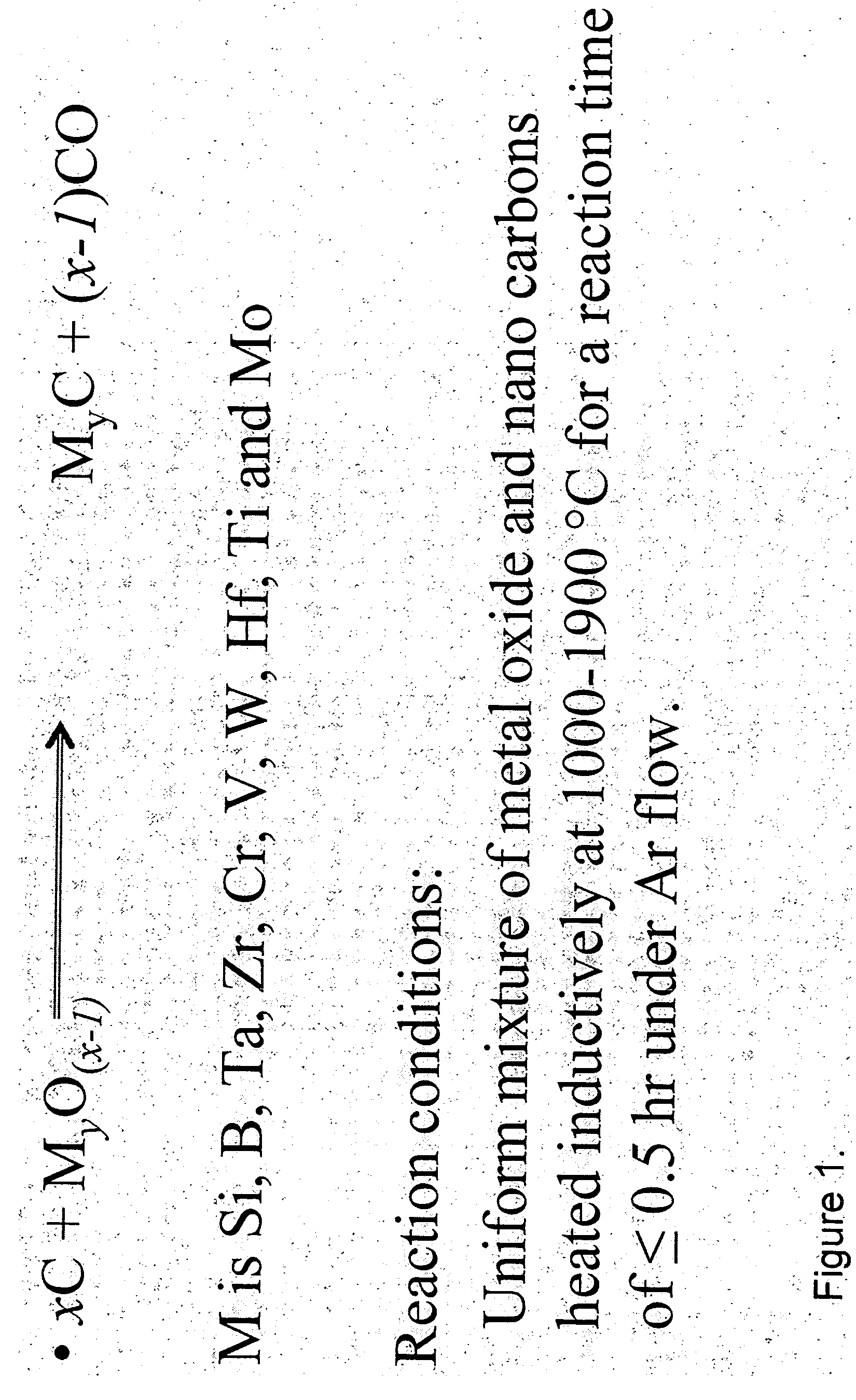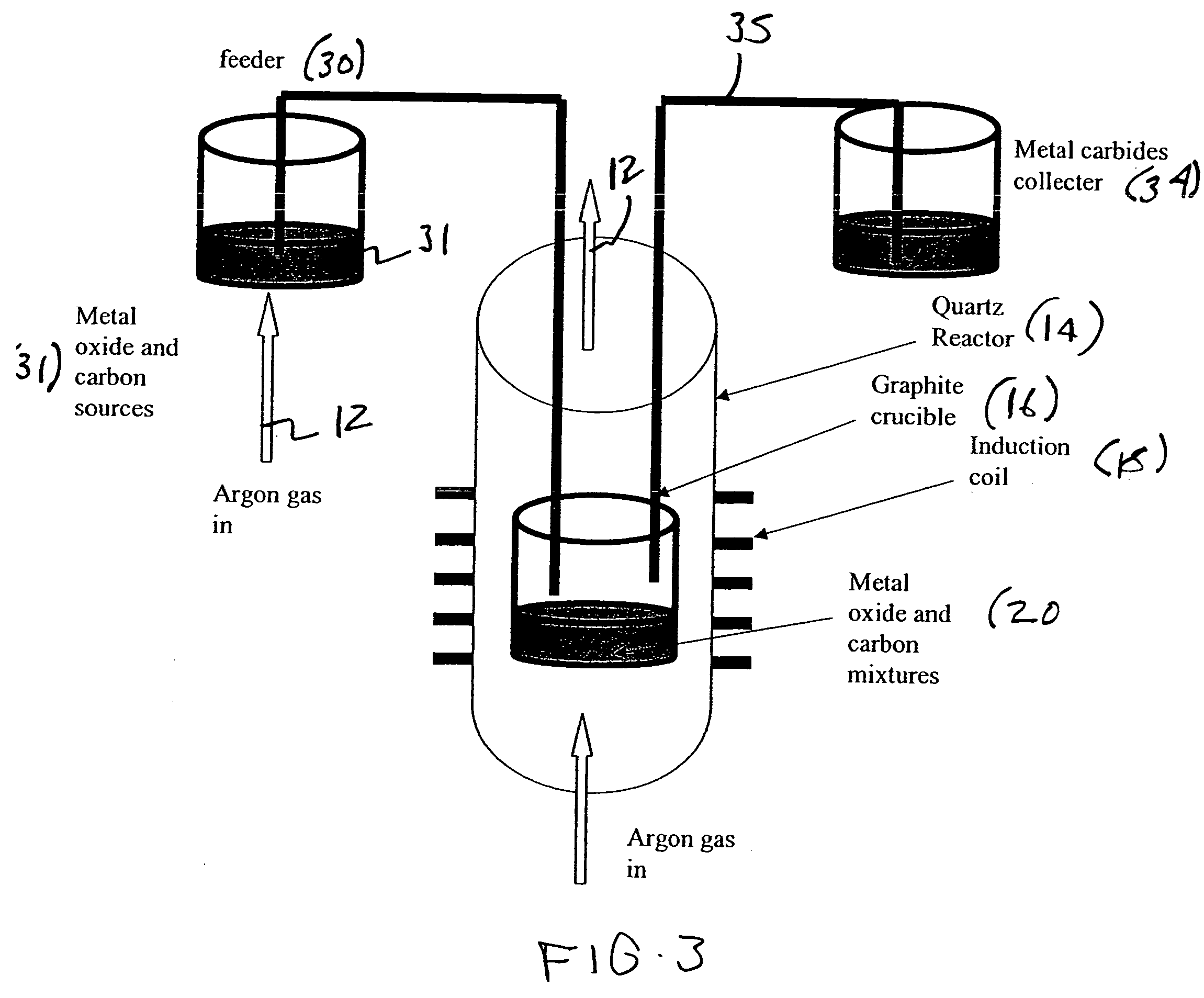Metal carbides and process for producing same
a metal carbide and metal carbide technology, applied in the field of metal carbide production, can solve the problems of less than complete conversion and increased particle size of metal carbide obtained, and achieve the effects of enhancing high temperature stability, improving wear resistance, and providing corrosion resistan
- Summary
- Abstract
- Description
- Claims
- Application Information
AI Technical Summary
Benefits of technology
Problems solved by technology
Method used
Image
Examples
experimental examples
Example One
SiO2+3C−→SiC+2CO
[0042] Silicon carbide powders were synthesized by using 10 g of silicon dioxide and 6 g of nanocarbon as precursor. The SiO2 powder had an average particle size of about 40 um and a specific surface area of 5 m2 / g, while the carbon sources were either a carbon black (CDX975, 253 m2 / g, with an average particle size 21 nm) or a filamentous nanocarbon (68.5 m2 / g with an average diameter of 70 nm). Initially, both carbon source and silicon dioxide were physically mixed using either a spatula or a ball mill, until well blended. The mixture was then placed in a graphite crucible and placed inside of a quartz vessel located within an induction coil. The vessel was purged with Ar gas with a flow of 1 SLM. After 30 min of purging, the temperature of the graphite crucible was increased to 1400° C. over 30 min and held at the desired temperature for <15 min. The graphite crucible was then cooled under Ar flow. An XRD pattern of the resulting sample showed that the...
example two
TiO2+3C−→TiC+2CO
[0043] Titanium carbide powders were synthesized by using 13.33 g of titanium dioxide and 6 g of nanocarbon as precursor. The TiO2 powder had an average particle size of about 32 nm and a specific surface area of 45 m2 / g, while the carbon sources were either a carbon black (CDX975, 253 m2 / g, with an average particle size 21 nm) or a filamentous nanocarbon (68.5 m2 / g with an average diameter of 70 nm). Initially, both carbon source and titanium dioxide were physically mixed using either a spatula or a ball mill, until well blended. The mixture was then placed in a graphite crucible and placed inside of a quartz vessel located within an induction coil. The vessel was purged with Ar gas with a flow of 1 SLM. After 30 min of purging, the temperature of the graphite crucible was increased to 1400° C. over 30 min and held at the desired temperature for <15 min. The graphite crucible was then cooled under Ar flow. An XRD pattern of the resulting sample showed that the part...
example three
Mo2O3+4C−→MO2C+3CO
[0044] Molybdenum carbide powders were synthesized by using 24 g of molybdenum dioxide and 6 g of nanocarbon as precursor. The Mo2O3 powder had an average particle size of about 20-40 nm and a specific surface area of 48 m2 / g, while the carbon sources were either a carbon black (CDX975, 253 m2 / g, with an average particle size 21 nm) or a filamentous nanocarbon (68.5 m2 / g with an average diameter of 70 nm). Initially, both carbon source and Molybdenum oxide were physically mixed using either a spatula or a ball mill, until well blended. The mixture was then placed in a graphite crucible and placed inside of a quartz vessel located within induction coil. The vessel was purged with Ar gas with a flow of 1 SLM. After 30 min of purging, the temperature of the graphite crucible was increased to 1350° C. over 30 min and held at the desired temperature for <15 min. The graphite crucible was then cooled under Ar flow. An XRD pattern of the resulting sample showed that the ...
PUM
| Property | Measurement | Unit |
|---|---|---|
| particle diameter | aaaaa | aaaaa |
| diameter | aaaaa | aaaaa |
| temperature | aaaaa | aaaaa |
Abstract
Description
Claims
Application Information
 Login to View More
Login to View More - R&D
- Intellectual Property
- Life Sciences
- Materials
- Tech Scout
- Unparalleled Data Quality
- Higher Quality Content
- 60% Fewer Hallucinations
Browse by: Latest US Patents, China's latest patents, Technical Efficacy Thesaurus, Application Domain, Technology Topic, Popular Technical Reports.
© 2025 PatSnap. All rights reserved.Legal|Privacy policy|Modern Slavery Act Transparency Statement|Sitemap|About US| Contact US: help@patsnap.com



